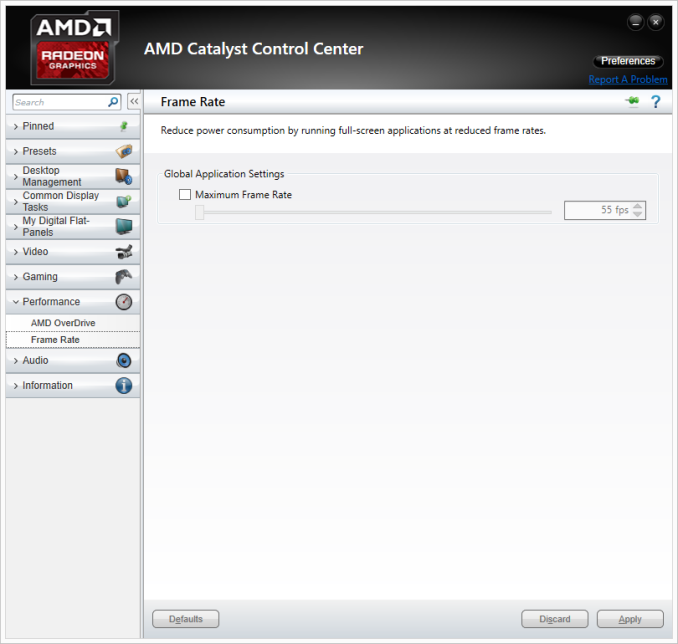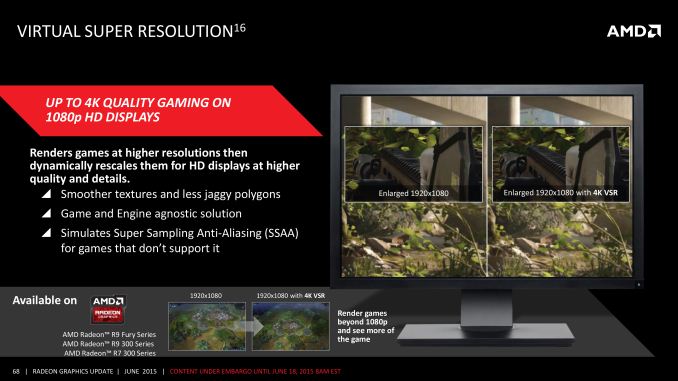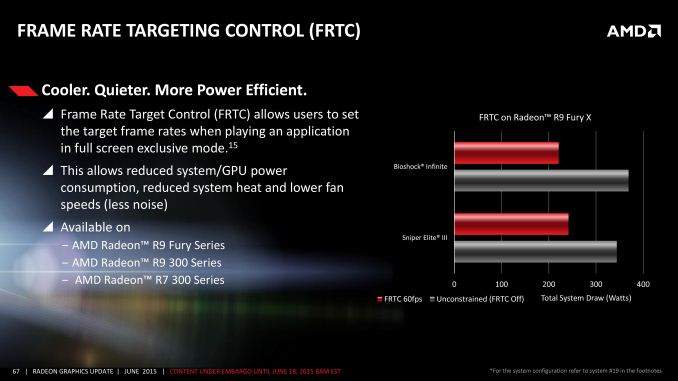The AMD Radeon R9 Fury X Review: Aiming For the Top
by Ryan Smith on July 2, 2015 11:15 AM ESTDisplay Matters: Virtual Super Resolution, Frame Rate Targeting, and HEVC Decoding
Wrapping up our look at the technical underpinnings of the Fiji GPU, we’ll end things with a look at the display and I/O stack for AMD’s latest GPU.
As a GCN 1.2 part, Fiji inherits most of its capabilities in-place from Tonga. There is one notable exception to this, HEVC, which we’ll get to in a bit, otherwise from a features standpoint you’re looking at the same display feature set as was on Tonga.
For Display I/O this means 6 display controllers capable of driving DVI, HDMI 1.4a, and DisplayPort 1.2a. Unfortunately because Tonga lacked support for HDMI 2.0, the same is true for Fiji, and as a result you can only drive 4k@60Hz displays either via DisplayPort, or via tandem HDMI connections. The good news here is that it will be possible to do active conversion from DisplayPort to HDMI 2.0 later this year, so Fiji is not permanently cut-off from HDMI 2.0, however those adapters aren’t here quite yet and there are still some unresolved questions to be addressed (e.g. HDCP 2.2).
On the multimedia front, Fiji brings with it an enhanced set of features from Tonga. While the video encode side (VCE) has not changed – AMD still supports a wide range of H.264 encode settings – the video decode side has seen a significant upgrade. Fiji is the first AMD discrete GPU to support full hardware HEVC decoding, coinciding with the launch of that feature on the GCN 1.2-based Carrizo APU as well.
A look at DXVA Checker confirms the presence of Main Profile (HEVC_VLD_Main) support, the official designation for 8-bit color support. Main profile is expected to be the most common profile level for HEVC content, so Fiji’s support of just Main profile should cover many use cases.
Unfortunately what you won’t find here is Main10 profile support, which is the profile for 10-bit color, and AMD has confirmed that 10-bit color support is not available on Fiji. As our in-house video guru Ganesh T S pointed out when looking at these results, Main10 is already being used in places you wouldn’t normally expect to see it, such as Netflix streaming. So there is some question over how useful Fiji’s HEVC decoder will be with commercial content, ignoring for now the fact that lack of Main10 support essentially rules out good support for some advanced color space features such as Rec. 2020, which needs higher bit depths to support the larger color space without extensive banding.
Meanwhile the state of AMD’s drivers with respect to video playback is hit and miss. DXVA Checker crashed when attempting to enumerate 4K resolution support on Fiji, and 4K has been something of a thorn in AMD’s side. This is also likely why Media Player Classic Home Cinema and its built-in LAV Filters are currently ignoring 4K support on Fiji and are falling back to software decoding. As a result 1080p hardware decoding works great on Fiji – both H.264 and HEVC – but getting Fiji to decode 4K content is a lot harder. Using Windows’ built-in H.264 decoder works for 4K H.264 decoding, and in the meantime it’s a bit harder to test Fiji’s HEVC capabilities at 4K since Windows 8 lacks an HEVC decoder.

Decoding 1080p HEVC In MPC-HC on Fiji
With full hardware decode support for HEVC still being relatively new in the PC space, I expect we’ll see some teething issues for some time yet. For the moment AMD needs to resolve any crashing issues and get off of LAV’s blacklist, since the LAV filters are by our estimation the most commonly used for generic HEVC media playback.
On a side note, given the fact that the Tonga GPU (R9 285) is the only GCN 1.2 GPU without HEVC decoding, I also took the liberty of quickly loading up a modified copy of the Catalyst 15.15 launch drivers for the R9 300/Fury series, and seeing if HEVC support may have been hidden in there the entire time. Even with these latest drivers, R9 285 does not support HEVC, and while I admittedly wasn’t expecting it to, I suspect there’s more to Tonga’s UVD block given its nature as the odd man out.
Last but not least, TrueAudio support is also included with Fiji. First introduced on AMD’s GCN 1.1 family, TrueAudio is AMD’s implementation of advanced hardware audio processing, powered by a cluster of Tensilica’s HiFi EP DSPs. Despite these DSPs being similar to what’s found on the PS4, we have not seen much in the way of support for TrueAudio in the last year outside of a few AMD-sponsored demos/titles, so thus far it remains an underutilized hardware feature.
Moving on, let’s talk software features. Back in December with their Omega Drivers, AMD introduced Virtual Super Resolution. VSR is AMD’s implementation of downsampling and is essentially the company’s answer to NVIDIA’s DSR technology.
However while VSR and DSR are designed to solve the same problem, the two technologies go about solving it in very different ways. With DSR NVIDIA implemented it as a shader program; it gave NVIDIA a lot of resolution flexibility in exchange for a slight performance hit, and for better or worse they threw in a Gaussian blur by default as well. AMD however opted to implement VSR directly against their display controllers, skipping the shading pipeline and the performance hit at a cost of flexibility.
Due to the nature of VSR and the fact that it heavily relies on the capabilities of AMD’s display controllers, only AMD’s newest generation display controllers offer the full range of virtual resolutions. The GCN 1.1 display controller, for example, could not offer 4K virtual resolutions, so the R9 290X and other high-end Hawaii cards topped out at a virtual resolution of 3200x1800 for 1080p and 1440p displays. With GCN 1.2 however, AMD’s newer display controller supports downsampling from 4K in at least some limited scenarios, and while this wasn’t especially useful for the R9 285, this is very useful for the R9 Fury X.
Overall for the R9 Fury X, the notable downsampling modes supported for the card are 3200x1800 (2.77x) and 3840x2160 (4.0x) for a native resolution of 1080p, 2560x1600 (1.77x) and 3840x2400 (4.0x) for a native resolution of 1200p, and unfortunately just 3200x1800 (1.56x) for a native resolution of 1440p. As a result VSR still can’t match the flexibility of DSR when it comes to resolutions, but AMD can finally offer 4K downsampling for 1080p panels, which allows for a nice (but expensive) 2x2 oversampling pattern, very similar to 4x ordered grid SSAA.
Finally, with AMD’s latest drivers they are also introducing a new framerate capping feature they are calling Frame Rate Target Control (FRTC). FRTC itself is not a new concept – 3rd party utilities such as MSI Afterburner and Radeon Pro have supported such functionality for a number of years now – however the change here is that AMD is finally bringing the technology into their drivers rather than requiring users to seek out 3rd party tools to do the job.

Frame Rate Target Control: From 55 fps to 95 fps
The purpose of FRTC is to allow users to cap the maximum framerate of a game without having to enable v-sync and the additional latency that can come from it, making for an effective solution that not v-sync and yet still places a hard cap on framerates. Note however that this is not a dynamic technology (ala NVIDIA’s Adaptive Sync), so there is no ability to dynamically turn v-sync on and off here. As for why users might want to cap their framerates, this is primarily due to the fact that video cards like the R9 Fury X can run circles around most older games, rendering framerates in to the hundreds at a time when even the fastest displays top out at 144Hz. Capping the frame rate serves to cut down on unnecessary work as a result, keeping the GPU from rendering frames that will never be seen.
AMD is only advertising FRTC support for the 300/Fury series at this time, so there is some question over whether we will see it brought over to AMD’s older cards. Given that AMD’s drivers are essentially split at the moment, I suspect we won’t have our final answer until the drivers get re-unified in a later release (most likely this month).















458 Comments
View All Comments
chizow - Friday, July 3, 2015 - link
Pretty much, AMD supporters/fans/apologists love to parrot the meme that Intel hasn't innovated since original i7 or whatever, and while development there has certainly slowed, we have a number of 18 core e5-2699v3 servers in my data center at work, Broadwell Iris Pro iGPs that handily beat AMD APU and approach low-end dGPU perf, and ultrabooks and tablets that run on fanless 5W Core M CPUs. Oh, and I've upgraded also managed to find meaningful desktop upgrades every few years for no more than $300 since Core 2 put me back in Intel's camp for the first time in nearly a decade.looncraz - Friday, July 3, 2015 - link
None of what you stated is innovation, merely minor evolution. The core design is the same, gaining only ~5% or so IPC per generation, same basic layouts, same basic tech. Are you sure you know what "innovation" means?Bulldozer modules were an innovative design. A failure, but still very innovative. Pentium Pro and Pentium 4 were both innovative designs, both seeking performance in very different ways.
Multi-core CPUs were innovative (AMD), HBM is innovative (AMD+Hynix), multi-GPU was innovative (3dfx), SMT was innovative (IBM, Alpha), CPU+GPU was innovative (Cyrix, IIRC)... you get the idea.
Doing the exact same thing, more or less the exact same way, but slightly better, is not innovation.
chizow - Sunday, July 5, 2015 - link
Huh? So putting Core level performance in a passive design that is as thin as a legal pad and has 10 hours of battery life isn't innovation?Increasing iGPU performance to the point it not only provides top-end CPU performance, and close to dGPU performance, while convincingly beating AMD's entire reason for buying ATI, their Fusion APUs isn't innovation?
And how about the data center where Intel's *18* core CPUs are using the same TDP and sockets, in the same U rack units as their 4 and 6 core equivalents of just a few years ago?
Intel is still innovating in different ways, that may not directly impact the desktop CPU market but it would be extremely ignorant to claim they aren't addressing their core growth and risk areas with new and innovative products.
I've bought more Intel products in recent years vs. prior strictly because of these new innovations that are allowing me to have high performance computing in different form factors and use cases, beyond being tethered to my desktop PC.
looncraz - Friday, July 3, 2015 - link
Show me intel CPU innovations since after the pentium 4.Mind you, innovations can be failures, they can be great successes, or they can be ho-hum.
P6->Core->Nehalem->Sandy Bridge->Haswell->Skylake
The only changes are evolutionary or as a result of process changes (which I don't consider CPU innovations).
This is not to say that they aren't fantastic products - I'm rocking an i7-2600k for a reason - they just aren't innovative products. Indeed, nVidia's Maxwell is a wonderfully designed and engineered GPU, and products based on it are of the highest quality and performance. That doesn't make them innovative in any way. Nothing technically wrong with that, but I wonder how long before someone else came up with a suitable RAM just for GPUs if AMD hadn't done it?
chizow - Sunday, July 5, 2015 - link
I've listed them above and despite slowing the pace of improvements on the desktop CPU side you are still looking at 30-45% improvement clock for clock between Nehalem and Haswell, along with pretty massive improvements in stock clock speed. Not bad given they've had literally zero pressure from AMD. If anything, Intel dominating in a virtual monopoly has afforded me much cheaper and consistent CPU upgrades, all of which provided significant improvements over the previous platform:E6600 $284
Q6600 $299
i7 920 $199!
i7 4770K $229
i7 5820K $299
All cheaper than the $450 AMD wanted for their ENTRY level Athlon 64 when they finally got the lead over Intel, which made it an easy choice to go to Intel for the first time in nearly a decade after AMD got Conroe'd in 2006.
silverblue - Monday, July 6, 2015 - link
I could swear that you've posted this before.I think the drop in prices were more of an attempt to strangle AMD than anything else. Intel can afford it, after all.
chizow - Monday, July 6, 2015 - link
Of course I've posted it elsewhere because it bears repeating, the nonsensical meme AMD fanboys love to parrot about AMD being necessary for low prices and strong competition is a farce. I've enjoyed unparalleled stability at a similar or higher level of relative performance in the years that AMD has become UNCOMPETITIVE in the CPU market. There is no reason to expect otherwise in the dGPU market.zoglike@yahoo.com - Monday, July 6, 2015 - link
Really? Intel hasn't innovated? I really hope you are trolling because if you believe that I fear for you.chizow - Thursday, July 2, 2015 - link
Let's not also discount the fact that's just stock comparisons, once you overclock the cards as many are interested in doing in this $650 bracket, especially with AMD's clams Fury X is an "Overclocker's Dream", we quickly see the 980Ti cannot be touched by Fury X, water cooler or not.Fury X wouldn't have been the failure it is today if not for AMD setting unrealistic and ultimately, unattained expectations. 390X WCE at $550-$600 and its a solid alternative. $650 new "Premium" Brand that doesn't OC at all, has only 4GB, has pump whine issues and is slower than Nvidia's same priced $650 980Ti that launched 3 weeks before it just doesn't get the job done after AMD hyped it from the top brass down.
andychow - Thursday, July 2, 2015 - link
Yeah, "Overclocker's dream", only overclocks by 75 MHz. Just by that statement, AMD has totally lost me.